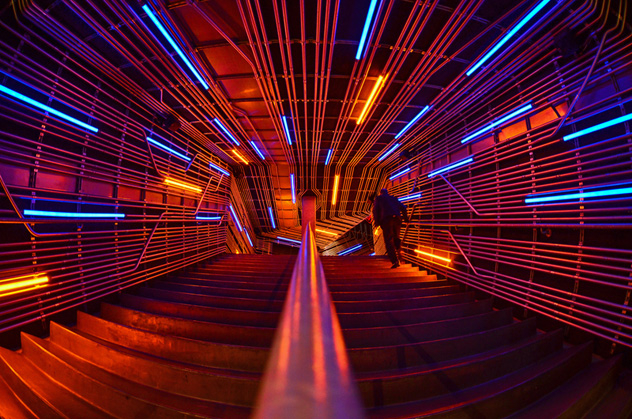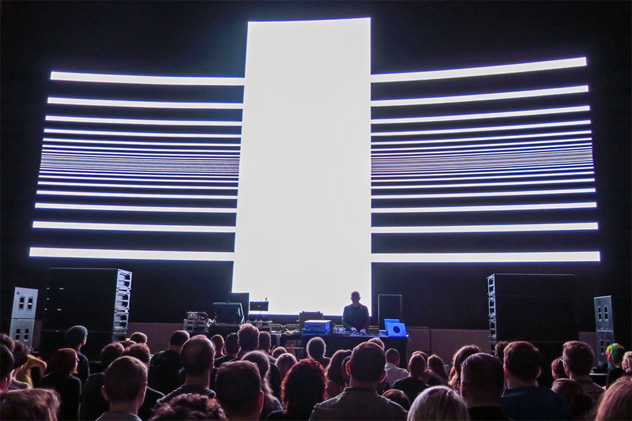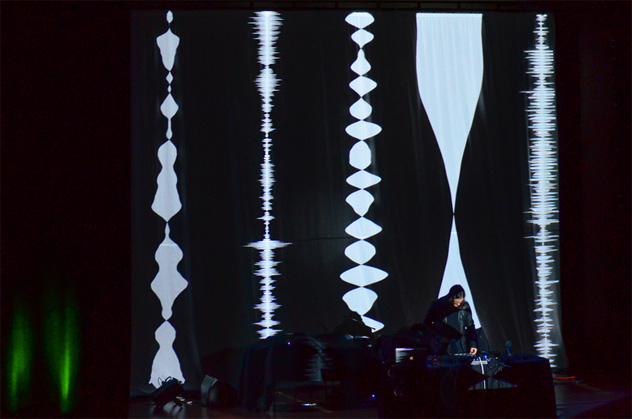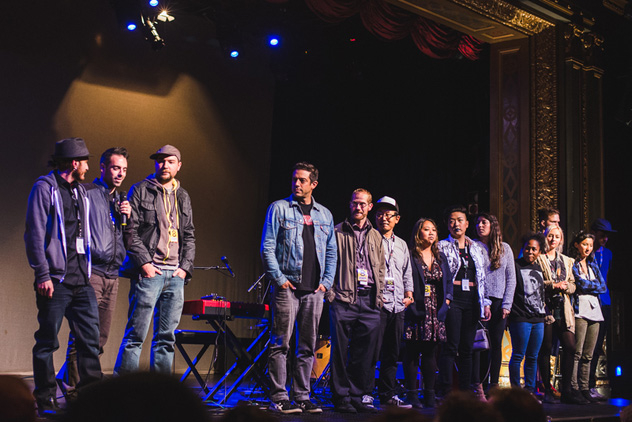- I wouldn't hesitate to call Decibel my favourite festival. That might have a lot to do with it happening in Seattle, which is a great city by any measure. Then there's the diverse programming, with a staggering number of artists spread across an equally ambitious number of venues. Each performance space is fine-tuned by festival staff, and existing soundsystems are bolstered where necessary. Each show gets its own set of visuals, too.
But this year, following last year's tenth birthday, things began to change. There was a shift in personnel (though founder Sean Horton is still at the helm), and Decibel moved away from its spiritual home of Capitol Hill and into Belltown's Experience Music Project museum. This made for some rather impressive venues, but it also gave an already sprawling event an even more fragmented feel.
The EMP building looks fantastic inside and out, and as the home for Decibel's daytime program of music tutorials and workshops, it outshone Broadway Performance Hall, which hosted the festival for the last few years. EMP housed three venues: the Sky Church (with its formidably large projection screen), the cavelike Level 3 and the sit-down JBL Theatre. They all looked and felt great, but they were all-ages, which split the crowds in half—those who wanted a drink were ID'd and penned into beer gardens. At the Sky Church, this meant being across a hallway from where the music was, to the point where you could barely tell what was going on. At Level 3, the bars were up on a balcony overlooking the venue. Crowds tended to congregate here, leaving the main floor a bit sparse.
 Logistics aside, the music at EMP was some of the best I've ever heard at Decibel. Modern Love drew a decent crowd at Level 3 with a roaring set from Andy Stott. Kangding Ray and Atom TM played stellar A/V sets in the Sky Church, assisted by the gloriously clear screens behind them. Oneohtrix Point Never's show there was equally powerful, but the lack of seating drove more impatient attendees away. BC label Silent Season's showcase at Level 3 was another major highlight that suffered because of its venue: an ambient showcase at a club-style space during peak hours on a Friday night just seemed like an odd choice, especially when there was a theatre in the same building that would have been perfect for it. Nevertheless, ASC and Segue played wonderfully, with the latter's dub techno chords billowing throughout the massive room.
Logistics aside, the music at EMP was some of the best I've ever heard at Decibel. Modern Love drew a decent crowd at Level 3 with a roaring set from Andy Stott. Kangding Ray and Atom TM played stellar A/V sets in the Sky Church, assisted by the gloriously clear screens behind them. Oneohtrix Point Never's show there was equally powerful, but the lack of seating drove more impatient attendees away. BC label Silent Season's showcase at Level 3 was another major highlight that suffered because of its venue: an ambient showcase at a club-style space during peak hours on a Friday night just seemed like an odd choice, especially when there was a theatre in the same building that would have been perfect for it. Nevertheless, ASC and Segue played wonderfully, with the latter's dub techno chords billowing throughout the massive room.
 Optical, Decibel's series of audiovisual events, made good use of the festival's traditional spaces. Nine Inch Nails associate Alessandro Cortini debuted a promising new live set at the prestigious Benaroya Hall, while The Triple Door—one of the best venues in the city—hosted a haunting performance from Loscil set against evocative black and white images of the Pacific Northwest. Sunday's Erased Tapes showcase featured a star turn from Douglas Dare and a satisfyingly raucous finish from Rival Consoles, plus the traditional (and emotional) closing statement from Sean Horton, who introduced Decibel's cast of characters (with several new faces among them).
Optical, Decibel's series of audiovisual events, made good use of the festival's traditional spaces. Nine Inch Nails associate Alessandro Cortini debuted a promising new live set at the prestigious Benaroya Hall, while The Triple Door—one of the best venues in the city—hosted a haunting performance from Loscil set against evocative black and white images of the Pacific Northwest. Sunday's Erased Tapes showcase featured a star turn from Douglas Dare and a satisfyingly raucous finish from Rival Consoles, plus the traditional (and emotional) closing statement from Sean Horton, who introduced Decibel's cast of characters (with several new faces among them).
 The only clubs in use at Capitol Hill were Neumos and Q. The latter was home to Decibel's official afterhours parties, scaled down from two per night last year. Despite its excellent lineups, Q was oddly sterile—even solid sets from Steffi and Marcel Dettmann at the Ostgut Ton showcase couldn't draw much energy out of the room. Belltown's Crocodile, on the other hand, had some of the most energetic crowds, even when they were somewhat thinned-out (as they were during Salva's home run of a closing set at Sunday night's Friends Of Friends showcase). Hyperdub's event packed the room on Saturday—Kode9 spun the best set I've ever seen him play, and the crew shared a toast on stage, celebrating the end of their year-long tenth anniversary tour. It was one of the rare moments of the festival that felt truly monumental.
Decibel came off a little uneven in 2014. A host of cancellations altered the lineup dramatically. Promised extras (like free rides on the Monorail to get to the EMP) never materialized, and the selection of venues was inconsistent. Neumos, a Decibel staple, was only used for two nights, while long-running institution Re-Bar was home to both official and unofficial events. One of those unofficial parties, put on by the local High & Tight crew and featuring Efdemin and Tin Man, had a joyous and communal vibe that seemed missing from Q, which points to a shift in Seattle's scene: in the past, Decibel seemed to unite Seattle clubbers under their banner, but in 2014, there were many tantalizing events on the side. Whether that's a sign of a fracturing community or just a byproduct of a flourishing electronic music scene is uncertain, but there's no doubt that Decibel was in a transitional state this year.
The only clubs in use at Capitol Hill were Neumos and Q. The latter was home to Decibel's official afterhours parties, scaled down from two per night last year. Despite its excellent lineups, Q was oddly sterile—even solid sets from Steffi and Marcel Dettmann at the Ostgut Ton showcase couldn't draw much energy out of the room. Belltown's Crocodile, on the other hand, had some of the most energetic crowds, even when they were somewhat thinned-out (as they were during Salva's home run of a closing set at Sunday night's Friends Of Friends showcase). Hyperdub's event packed the room on Saturday—Kode9 spun the best set I've ever seen him play, and the crew shared a toast on stage, celebrating the end of their year-long tenth anniversary tour. It was one of the rare moments of the festival that felt truly monumental.
Decibel came off a little uneven in 2014. A host of cancellations altered the lineup dramatically. Promised extras (like free rides on the Monorail to get to the EMP) never materialized, and the selection of venues was inconsistent. Neumos, a Decibel staple, was only used for two nights, while long-running institution Re-Bar was home to both official and unofficial events. One of those unofficial parties, put on by the local High & Tight crew and featuring Efdemin and Tin Man, had a joyous and communal vibe that seemed missing from Q, which points to a shift in Seattle's scene: in the past, Decibel seemed to unite Seattle clubbers under their banner, but in 2014, there were many tantalizing events on the side. Whether that's a sign of a fracturing community or just a byproduct of a flourishing electronic music scene is uncertain, but there's no doubt that Decibel was in a transitional state this year.
 The positives overwhelmingly outweighed the negatives. I also saw highlight sets from Rrose, Vatican Shadow, Nadastrom and Simian Mobile Disco. There were two boat parties, plus a whole world of EDM-leaning acts like Paper Diamond and Sweater Beats to satisfy the city's younger crowd, plus some more indie-leaning artists. No one person's Decibel experience will be the same as anyone else's, and that's because the festival offers an incredible amount to choose from. If anything hasn't changed, it's Decibel's ability to cater to a wide variety of audiences without pandering or compromising, and that's a big part of what makes it so exciting.
As Seattle's interest in dance music—which Decibel helped to breed—continues to evolve, so does the festival itself. When I talked to Sean Horton last year, he wondered how Decibel could continue after last year's tenth birthday blowout. Moving into their 11th edition, it seemed like he was still figuring that out. By now, Decibel has only its own considerable legacy to live up to, and that's why even in the midst of transformation it still delivered an underground-friendly electronic music festival bigger and better than most in North America.
The positives overwhelmingly outweighed the negatives. I also saw highlight sets from Rrose, Vatican Shadow, Nadastrom and Simian Mobile Disco. There were two boat parties, plus a whole world of EDM-leaning acts like Paper Diamond and Sweater Beats to satisfy the city's younger crowd, plus some more indie-leaning artists. No one person's Decibel experience will be the same as anyone else's, and that's because the festival offers an incredible amount to choose from. If anything hasn't changed, it's Decibel's ability to cater to a wide variety of audiences without pandering or compromising, and that's a big part of what makes it so exciting.
As Seattle's interest in dance music—which Decibel helped to breed—continues to evolve, so does the festival itself. When I talked to Sean Horton last year, he wondered how Decibel could continue after last year's tenth birthday blowout. Moving into their 11th edition, it seemed like he was still figuring that out. By now, Decibel has only its own considerable legacy to live up to, and that's why even in the midst of transformation it still delivered an underground-friendly electronic music festival bigger and better than most in North America.
 Logistics aside, the music at EMP was some of the best I've ever heard at Decibel. Modern Love drew a decent crowd at Level 3 with a roaring set from Andy Stott. Kangding Ray and Atom TM played stellar A/V sets in the Sky Church, assisted by the gloriously clear screens behind them. Oneohtrix Point Never's show there was equally powerful, but the lack of seating drove more impatient attendees away. BC label Silent Season's showcase at Level 3 was another major highlight that suffered because of its venue: an ambient showcase at a club-style space during peak hours on a Friday night just seemed like an odd choice, especially when there was a theatre in the same building that would have been perfect for it. Nevertheless, ASC and Segue played wonderfully, with the latter's dub techno chords billowing throughout the massive room.
Logistics aside, the music at EMP was some of the best I've ever heard at Decibel. Modern Love drew a decent crowd at Level 3 with a roaring set from Andy Stott. Kangding Ray and Atom TM played stellar A/V sets in the Sky Church, assisted by the gloriously clear screens behind them. Oneohtrix Point Never's show there was equally powerful, but the lack of seating drove more impatient attendees away. BC label Silent Season's showcase at Level 3 was another major highlight that suffered because of its venue: an ambient showcase at a club-style space during peak hours on a Friday night just seemed like an odd choice, especially when there was a theatre in the same building that would have been perfect for it. Nevertheless, ASC and Segue played wonderfully, with the latter's dub techno chords billowing throughout the massive room.
 Optical, Decibel's series of audiovisual events, made good use of the festival's traditional spaces. Nine Inch Nails associate Alessandro Cortini debuted a promising new live set at the prestigious Benaroya Hall, while The Triple Door—one of the best venues in the city—hosted a haunting performance from Loscil set against evocative black and white images of the Pacific Northwest. Sunday's Erased Tapes showcase featured a star turn from Douglas Dare and a satisfyingly raucous finish from Rival Consoles, plus the traditional (and emotional) closing statement from Sean Horton, who introduced Decibel's cast of characters (with several new faces among them).
Optical, Decibel's series of audiovisual events, made good use of the festival's traditional spaces. Nine Inch Nails associate Alessandro Cortini debuted a promising new live set at the prestigious Benaroya Hall, while The Triple Door—one of the best venues in the city—hosted a haunting performance from Loscil set against evocative black and white images of the Pacific Northwest. Sunday's Erased Tapes showcase featured a star turn from Douglas Dare and a satisfyingly raucous finish from Rival Consoles, plus the traditional (and emotional) closing statement from Sean Horton, who introduced Decibel's cast of characters (with several new faces among them).
 The only clubs in use at Capitol Hill were Neumos and Q. The latter was home to Decibel's official afterhours parties, scaled down from two per night last year. Despite its excellent lineups, Q was oddly sterile—even solid sets from Steffi and Marcel Dettmann at the Ostgut Ton showcase couldn't draw much energy out of the room. Belltown's Crocodile, on the other hand, had some of the most energetic crowds, even when they were somewhat thinned-out (as they were during Salva's home run of a closing set at Sunday night's Friends Of Friends showcase). Hyperdub's event packed the room on Saturday—Kode9 spun the best set I've ever seen him play, and the crew shared a toast on stage, celebrating the end of their year-long tenth anniversary tour. It was one of the rare moments of the festival that felt truly monumental.
Decibel came off a little uneven in 2014. A host of cancellations altered the lineup dramatically. Promised extras (like free rides on the Monorail to get to the EMP) never materialized, and the selection of venues was inconsistent. Neumos, a Decibel staple, was only used for two nights, while long-running institution Re-Bar was home to both official and unofficial events. One of those unofficial parties, put on by the local High & Tight crew and featuring Efdemin and Tin Man, had a joyous and communal vibe that seemed missing from Q, which points to a shift in Seattle's scene: in the past, Decibel seemed to unite Seattle clubbers under their banner, but in 2014, there were many tantalizing events on the side. Whether that's a sign of a fracturing community or just a byproduct of a flourishing electronic music scene is uncertain, but there's no doubt that Decibel was in a transitional state this year.
The only clubs in use at Capitol Hill were Neumos and Q. The latter was home to Decibel's official afterhours parties, scaled down from two per night last year. Despite its excellent lineups, Q was oddly sterile—even solid sets from Steffi and Marcel Dettmann at the Ostgut Ton showcase couldn't draw much energy out of the room. Belltown's Crocodile, on the other hand, had some of the most energetic crowds, even when they were somewhat thinned-out (as they were during Salva's home run of a closing set at Sunday night's Friends Of Friends showcase). Hyperdub's event packed the room on Saturday—Kode9 spun the best set I've ever seen him play, and the crew shared a toast on stage, celebrating the end of their year-long tenth anniversary tour. It was one of the rare moments of the festival that felt truly monumental.
Decibel came off a little uneven in 2014. A host of cancellations altered the lineup dramatically. Promised extras (like free rides on the Monorail to get to the EMP) never materialized, and the selection of venues was inconsistent. Neumos, a Decibel staple, was only used for two nights, while long-running institution Re-Bar was home to both official and unofficial events. One of those unofficial parties, put on by the local High & Tight crew and featuring Efdemin and Tin Man, had a joyous and communal vibe that seemed missing from Q, which points to a shift in Seattle's scene: in the past, Decibel seemed to unite Seattle clubbers under their banner, but in 2014, there were many tantalizing events on the side. Whether that's a sign of a fracturing community or just a byproduct of a flourishing electronic music scene is uncertain, but there's no doubt that Decibel was in a transitional state this year.
 The positives overwhelmingly outweighed the negatives. I also saw highlight sets from Rrose, Vatican Shadow, Nadastrom and Simian Mobile Disco. There were two boat parties, plus a whole world of EDM-leaning acts like Paper Diamond and Sweater Beats to satisfy the city's younger crowd, plus some more indie-leaning artists. No one person's Decibel experience will be the same as anyone else's, and that's because the festival offers an incredible amount to choose from. If anything hasn't changed, it's Decibel's ability to cater to a wide variety of audiences without pandering or compromising, and that's a big part of what makes it so exciting.
As Seattle's interest in dance music—which Decibel helped to breed—continues to evolve, so does the festival itself. When I talked to Sean Horton last year, he wondered how Decibel could continue after last year's tenth birthday blowout. Moving into their 11th edition, it seemed like he was still figuring that out. By now, Decibel has only its own considerable legacy to live up to, and that's why even in the midst of transformation it still delivered an underground-friendly electronic music festival bigger and better than most in North America.
The positives overwhelmingly outweighed the negatives. I also saw highlight sets from Rrose, Vatican Shadow, Nadastrom and Simian Mobile Disco. There were two boat parties, plus a whole world of EDM-leaning acts like Paper Diamond and Sweater Beats to satisfy the city's younger crowd, plus some more indie-leaning artists. No one person's Decibel experience will be the same as anyone else's, and that's because the festival offers an incredible amount to choose from. If anything hasn't changed, it's Decibel's ability to cater to a wide variety of audiences without pandering or compromising, and that's a big part of what makes it so exciting.
As Seattle's interest in dance music—which Decibel helped to breed—continues to evolve, so does the festival itself. When I talked to Sean Horton last year, he wondered how Decibel could continue after last year's tenth birthday blowout. Moving into their 11th edition, it seemed like he was still figuring that out. By now, Decibel has only its own considerable legacy to live up to, and that's why even in the midst of transformation it still delivered an underground-friendly electronic music festival bigger and better than most in North America.